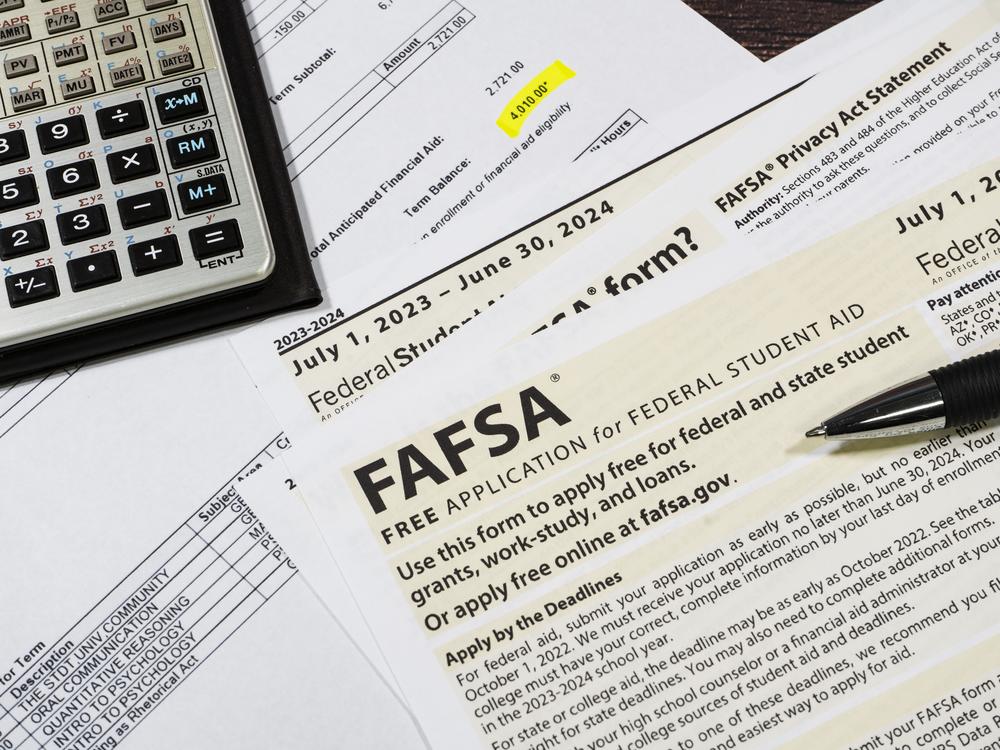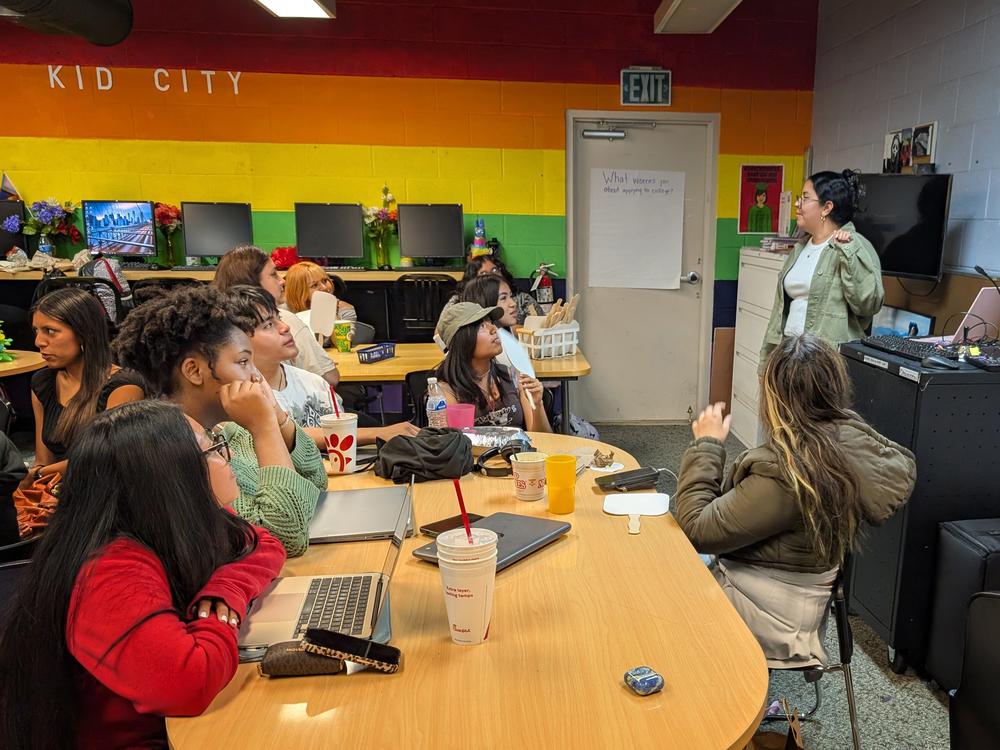Section Branding
Header Content
Some students are fighting to stay in college after the FAFSA delayed financial aid
Primary Content
Brenda H. almost didn’t make it to her first day of college. She tried to apply for financial aid through the Free Application for Federal Student Aid (FAFSA) four times, but encountered glitch after glitch – including a widespread bug that impacted students whose parents or spouses don’t have Social Security numbers. Brenda’s parents are both undocumented, which is why Brenda requested we keep their last name out of this story.
It wasn’t until her fifth attempt this spring that Brenda was finally able to submit her FAFSA. The delay meant she committed to a college – California State University, Northridge – without knowing if she could afford it.
“I was entering college blind,” she says as she thinks back to that decision.
When her financial aid package finally came, she says she was speechless. “My mouth dropped to the floor.” There were only a few weeks left before school started, and her award offer was much lower than she had planned for. “I was mad at FAFSA,” she says. “So I went in blind, I went in confused, and I went in angry.”
The FAFSA debacle has followed students like Brenda into the school year, as the repercussions of months-long delays from the last financial aid cycle continue to play out. Many colleges traditionally ask students to commit to their school by May 1, but the National College Attainment Network estimated that, compared to last year, about 408,000 fewer high school seniors had successfully completed their FAFSA as of that week. Some colleges responded by pushing their commitment deadlines, but the delays still left Brenda, and others like her, forced to make all kinds of decisions about college without knowing how they would pay for it. Now, many of those students are fighting to stay in school.
For Brenda, that meant scrambling to find housing nearby – a room that’s a 30-minute bus ride from campus – and making her own lunches to save money. She’s hoping to get more aid out of the next FAFSA cycle, which has again been delayed.
The U.S. Department of Education began testing this year’s form with a limited number of students on Oct. 1, the form’s traditional release date. The agency says it’s working to fix glitches and release the application to all students by Dec. 1.
“I’m wondering how I’m going to pay for the next semester”
Brenda’s mom is a seamstress and her dad works for a bulk spice market. Nobody in her family has ever been to college, so she didn’t grow up thinking she’d get a degree.
That changed in 11th grade, when Brenda started taking drum lessons in the basement of a local nonprofit in Downtown Los Angeles. Kid City Hope Place serves low-income students with educational programs, financial aid help and activities meant to get them excited about higher education.
“I remember I was so scared of the upstairs kids because they were all about college, all about [their] future. And back in junior year, I didn’t even think I would go to college,” Brenda says.
Kim Fabian, the project director at Kid City, jokes that their music program is just a way to draw kids to the college access program upstairs. "It actually is one of the tactics we use for some of the students who might fall between the cracks – the students that aren't high achieving, but aren't low achieving, and they get stuck somewhere in the middle. They just need a gentle push."
That was the case for Brenda, who says, “I just didn't see a future for myself. But once I started going to the [college access] program at the end of my junior year, they encouraged me to apply to college, and encouraged me to apply for the FAFSA. They encouraged me to just go for it. Like, ‘You won’t regret this.’ ”
Brenda’s counselors told her that because her family was low-income, she would likely qualify for substantial financial aid. Excited about the prospect of going to a four-year university, Brenda forged ahead and applied to colleges last fall, and then to the FAFSA.
Fabian says she didn’t know what to say earlier this year when the FAFSA application process failed every single Kid City family who applied. “It felt like a broken promise,” she says. “It was impossible to not feel that guilty feeling because we’re the intermediaries that are supposed to make these dreams happen, make this possible, give you a hand, talk you through the process.”
Even though the delays caused Brenda anxiety, she felt better when she saw her friends from higher-income families receive enough aid to cover their education. She was certain the same would be true for her. But when Brenda’s financial aid offer finally came in July, just a few weeks before school was set to begin, “I completely panicked,” she says.
She received a Pell Grant for $970 per semester, and was offered $2,750 in federal student loans each semester. That aid amount just about covers her tuition, but she’s on her own when it comes to housing, food, books and transportation.
And while Brenda did manage to cobble together enough money to start classes in the fall, she says the financial stress has made it hard to focus on her actual education.
“It makes me think about my future … and sometimes I’ll catch myself not focusing in class because I’m wondering how I’m going to pay for the next semester.”
Not just an application, but a gateway to “a life plan”
Brenda is majoring in psychology. She has struggled with her own mental health and couldn’t get the help she needed, so she wants to become a therapist to help kids like her. But she’s worried about whether she can afford to finish her degree.
Brenda says this whole experience made her realize that, for her, the FAFSA isn’t just a bureaucratic application that results in a sum of money – it’s a gateway to “a life-plan.” Had she gotten her aid package in a timely manner, she could have made a more informed decision about college, applied to scholarships and maybe the entire thing would have been less stressful.
“This whole process, everything I experienced, just traumatized me.”
She says it was frustrating to hear the form was delayed again this year, but every time she feels discouraged about paying for her education, she thinks about her 2- and 3-year-old nieces.
“I want to be a role model for them. I want them to know, ‘You can go to college. You’re not bound to be like your parents, you’re not bound to be like your grandparents. You can go to college and make a name for yourself.’ ”
As she waits to apply to the next FAFSA, she’s trying to stay focused on her coursework, and on her newfound independence. Recently, she stayed out past midnight for the first time, and had her first sleepover.
“I was like ‘Wow! I feel so independent. I feel so adult.’ I've been experiencing a lot more in college than I did in the past 17 years of my life.”
Now, Brenda hopes she can keep having those new life experiences. But it’ll depend on whether she can afford to keep getting the education she never even dreamed of.


